World’s Biggest Sweet Potato (24.9 Lbs or 11.2 Kg)

Lebanese farmer Khalil Semhat, from the southern city of Tyre, couldn’t believe his peeled eyes when he discovered he had grown a massive potato weighing 11.3 kilos (24.9 pounds), setting a record for the world’s largest potato.
Worlds Largest Marrow (113 Lbs or 65 Kg)
Worlds Largest Marrow (113 Lbs or 65 Kg)

Grown by Ken Dade in Norfolk, the 65kg (113lbs) vegetable needed two men to carry it to a stand at the National Amateur Gardening Show in Somerset. The voluptuous vegetable has entered the Guinness World Records book, beating the previous world title holder by 3kg.
World’s Heaviest Jackfruit (76 Lbs or 34.4 Kg)
World’s Heaviest Jackfruit (76 Lbs or 34.4 Kg)

The sweet tasting fruit weighed 34.6kg (76lb 4.4oz), measured 57.46 cm (22.625in) long and had a circumference of 121.28 cm on 8 August 2003. It was grown by George and Margaret Schattauer of Captai Cook, Hawaii, USA. Native to Western India, the fruit spread throughout South East Asia and first came to Hawaii in 1888.
World’s Largest Green Cabbage (76 Lbs or 34.4 Kg)
World’s Largest Green Cabbage (76 Lbs or 34.4 Kg)

John Evans, a mechanical designer who lives 40 miles north of Anchorage in Palmer, Alaska, holds seven world records for giant vegetables. One of them is this Green Cabbage, who weighted over 76 lb, making it a world record in 1998.
World’s Largest Watermelon (268.8 Lbs or 122 Kg)
World’s Largest Watermelon (268.8 Lbs or 122 Kg)

Weighting 268.8 pounds, this watermelon made the cut as the world’s largest watermelon. Grown at the Hope Farm Store by Lloyd Bright, his family has a long history with watermelons: they set world records in melon size in 1979 with a 200 pound melon and again in 1985 with one that weighed 260 pounds.
World’s Heaviest Carrot (18.9 Lbs or 8.5 Kg)
World’s Heaviest Carrot (18.9 Lbs or 8.5 Kg)

Presented by John Evans in 1998, this 18.985 pound (8.61 kg) carrot is the heaviest ever.
World’s Largest Pumpkin (1689 Lbs or 766 Kg)
World’s Largest Pumpkin (1689 Lbs or 766 Kg)

Grown in Rhode Island, the world’s biggest pumpkin was shown at the Topsfield Fair of Massachusetts in 2007, weighing 1689 lbs.
World’s Longest Cucumber (36.1 in or 0.9 mts)
World’s Longest Cucumber (36.1 in or 0.9 mts)

The 36.1in cucumber was grown by Alf Cobb who beat his own record of 35.1in at the National Amateur Gardening Show, from the Bath and West Showground in south-west England.
World’s Largest Cauliflower (31.25 Lbs or 14.1 Kg)
World’s Largest Cauliflower (31.25 Lbs or 14.1 Kg)

Also grown by Evans, this Cauliflower weighted 31.25 lb, making it Alaska’s largest one in 1997.
World’s Heaviest Broccoli (35 Lbs or 15.8 Kg)
World’s Heaviest Broccoli (35 Lbs or 15.8 Kg)

In what was John Evans’ first World record in 1993, this Broccoli weighted over 35 lb, making it a world record.
“Freedom of the Seas”
M/S Freedom of the Seas is a Royal Caribbean International cruise ship. The world’s largest passenger vessel, she can accommodate over 4,300 passengers on her fifteen passenger decks, served by over 1300 crew.
She is about 229 ft. longer, about 108,000 gross tons larger, and can accommodate 2,147 more passengers than RMS Titanic. Her operating costs are $1 million per day. Rooms for the maiden voyage were priced from $1,900 to $22,000 for the week. As routine service continues, starting room rates are expected to descend as low as $700 for cruises scheduled in the autumn of 2007. The ship consumes approximately 28,000 gallons of fuel per hour.
She is about 229 ft. longer, about 108,000 gross tons larger, and can accommodate 2,147 more passengers than RMS Titanic. Her operating costs are $1 million per day. Rooms for the maiden voyage were priced from $1,900 to $22,000 for the week. As routine service continues, starting room rates are expected to descend as low as $700 for cruises scheduled in the autumn of 2007. The ship consumes approximately 28,000 gallons of fuel per hour.
Facilities -
The ship features three swimming areas; an interactive water park, a dedicated adult pool and the main pool. There are 2 whirlpools cantilevered out from the ship’s sides. The Royal Promenade sports a coffee shop, Sorrento’s Pizzeria, a Ben and Jerry’s ice-cream shop, Vintage’s winery, the Bull and Bear Irish pub, and many Duty-free shops. The 13th deck features a sports area with amenities such as a rock climbing wall, the FlowRider (an onboard wave generator for surfing), a miniature golf course and a full size basketball court. Other items include an ice skating rink, a casino, a Johnny Rockets, Wi-Fi capabilities throughout the ship, flat panel televisions in all staterooms, and cell phone connectivity.
The ship features three swimming areas; an interactive water park, a dedicated adult pool and the main pool. There are 2 whirlpools cantilevered out from the ship’s sides. The Royal Promenade sports a coffee shop, Sorrento’s Pizzeria, a Ben and Jerry’s ice-cream shop, Vintage’s winery, the Bull and Bear Irish pub, and many Duty-free shops. The 13th deck features a sports area with amenities such as a rock climbing wall, the FlowRider (an onboard wave generator for surfing), a miniature golf course and a full size basketball court. Other items include an ice skating rink, a casino, a Johnny Rockets, Wi-Fi capabilities throughout the ship, flat panel televisions in all staterooms, and cell phone connectivity.
World’s Largest Butterfly
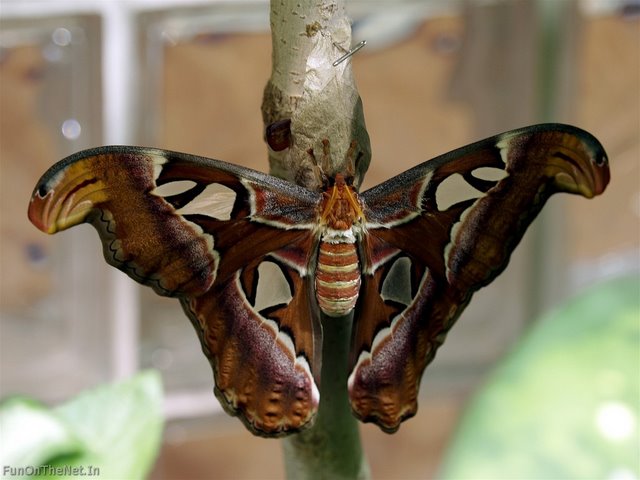

The Atlas moth (Attacus atlas) is a large saturniid moth found in the tropical and subtropical forests of Southeast Asia, southern China, common across the Malay archipelago, Thailand to Indonesia.
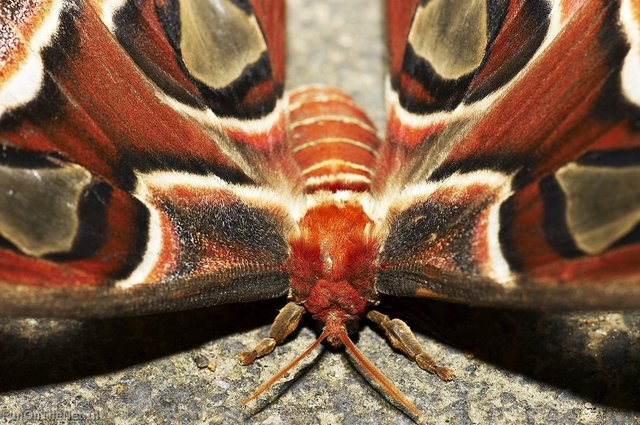
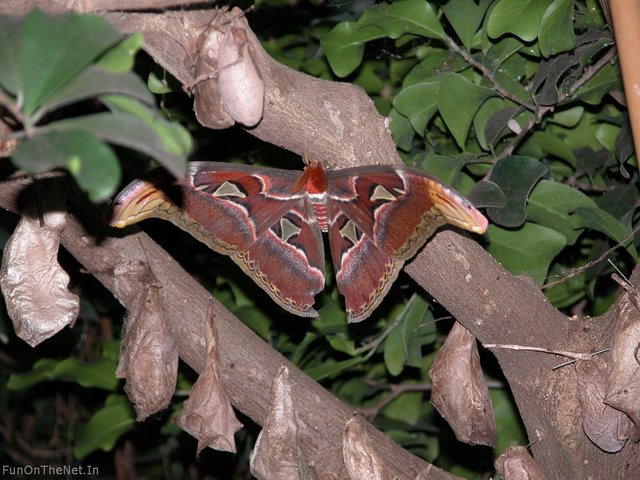

In India, Atlas moths are cultivated for their silk in a non-commercial capacity; unlike that produced by the related Silkworm moth (Bombyx mori), Atlas moth silk is secreted as broken strands. This brown, wool-like silk is thought to have greater durability and is known as fagara. Atlas moth cocoons have been employed as purses in Taiwan.
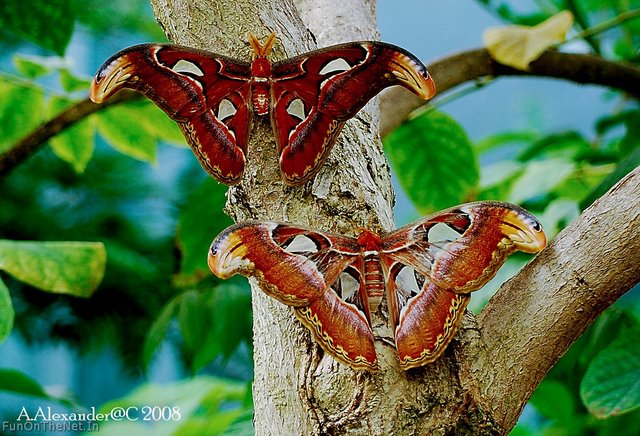


Atlas moths are considered to be the largest moths in the world in terms of total wing surface area (upwards of c. 400 square cm or 65 square inches). Their wingspans are also amongst the largest, from 25-30 cm (10-12 inches). Females are appreciably larger and heavier.



Atlas moths are said to be named after either the Titan of Greek mythology, or their map-like wing patterns. In Hong Kong the Cantonese name translates as “snake’s head moth”, referring to apical extension of the forewing, which bears a passing resemblance to a snake’s head.


Atlas moths are predominantly tawny to maroon in colour with roughly triangular, diaphanous “eyes” on both forewing and hindwing, bordered in black. The purpose of these dramatic, gossamer portals is not clear, but they are thought to play a role in predator avoidance. Their bodies are hairy and disproportionately small compared to their wings.

World’s Biggest Dog

Say hello to this gargantuan specimen named Hercules, purportedly the Guinness Record holder for World’s Biggest Dog. Hercules is an English Mastiff and has a 38 inch neck and weighs 282 pounds.
With “paws the size of softballs”, the three-year-old monster is far larger and heavier than his breed’s standard 200lb. limit. Hercules owner Mr. Flynn says that Hercules weight is natural and not induced by a bizarre diet: “I fed him normal food and he just grew, and grew, and grew”.
With “paws the size of softballs”, the three-year-old monster is far larger and heavier than his breed’s standard 200lb. limit. Hercules owner Mr. Flynn says that Hercules weight is natural and not induced by a bizarre diet: “I fed him normal food and he just grew, and grew, and grew”.
World’s Biggest Horse

Radar, a Belgian draught horse, is the World’s Tallest Living Horse. This huge horse, at 6ft 71/2in from hoof to shoulder, is from Mount Pleasant, Texas. At 2,400lb, he has a giant appetite to match, putting away 20 gallons of water a day and 18lb of grain.
World’s Biggest Cow

As big as a small elephant, Big Cow Chilli and he’s described as a gentle giant. Chilli the giant bullock stands at 6ft 6ins and weighs well over a ton. Despite his grand stature, Chilli only grazes on grass during the day and enjoys the occasional swede as a treat.
World’s Biggest Pig

The Liaoning Provincial Agricultural Museum is appealing to the Guinness Book of Records to recognise a 900 kg (1984 pounds) pig which died on February 5 as the biggest pig ever. When the pig died it was 2.5 metres long, had a waistline of 2.23 metres and a tusk of 14.4 centimetres long. According to XU Changjin, a farmer of Wafangdian city, the pig was only 5 years old. He kept his pig in a good built sty and gave it quality food all its life.
World’s Biggest Catfish
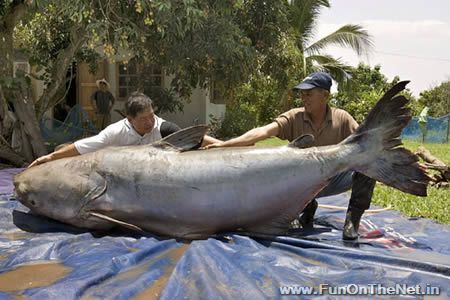
At 646LB this Mekong Giant Catfish is the largest freshwater fish in the world. With nearly nine feet long (2.7 meters) and as big as a grizzly bear, this huge catfish caught in northern Thailand may be the largest freshwater fish ever recorded. Although there are many claims and rumours about the world’s largest freshwater specimens, especially from misguided anglers. However, in the eyes of scientist’s the Mekong Giant Catfish has taken pole position with the recorded capture of this huge 646LB specimen by local fishermen in 2005. Many anglers over look the fact that some larger fish that can be caught in the worlds rivers, such as Sturgeon, migrate between river and sea, and therefore not considered to be freshwater species in the true sense of the word.
World’s Biggest Stingray ever caught
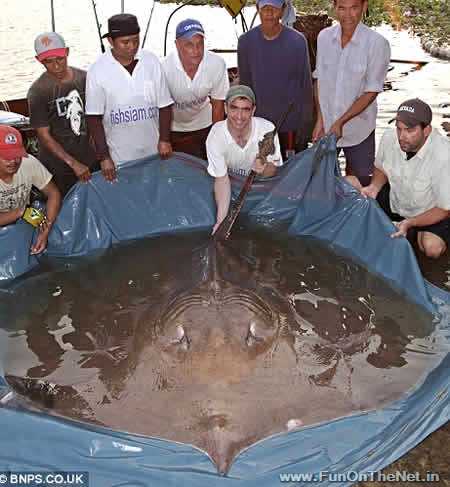
It took 90 minutes to land, 13 men to heave it out of the water… and weighed 55 stone when they finally got it to the scales. So it’s little wonder that when Ian Welch first hooked the record stingray, it almost pulled him into the river. The angler, from Aldershot, Hampshire, was fishing in Thailand when he landed the ray, which is the biggest freshwater fish to be caught with a rod, with over 7ft long and wide, with a tail of 10ft.
World’s Biggest Shark ever caught

More likely to eat than be eaten, this giant whale shark was caught off the coast of China by hardcore fishermen who managed to harness the ten-metre, eight-tonne whopper. Whale sharks are the world’s largest living fish, it is estimated that they can reach an 18 metre length. They live in warm water along the coast and open seas and spend most of their time near the surface.
Whale Shark – The Worlds Biggest Fish!
The whale shark, Rhincodon typus, is a slow moving filter feeding shark that is the largest living fish species. It can grow up to 12.2 m. (40 ft.) in length and can weigh up to 13.6 tonnes (15 short tons). . The shark is found in tropical and warm oceans and lives in the open sea and can live for about 70 years. The species is believed to have originated about 60 million years ago.
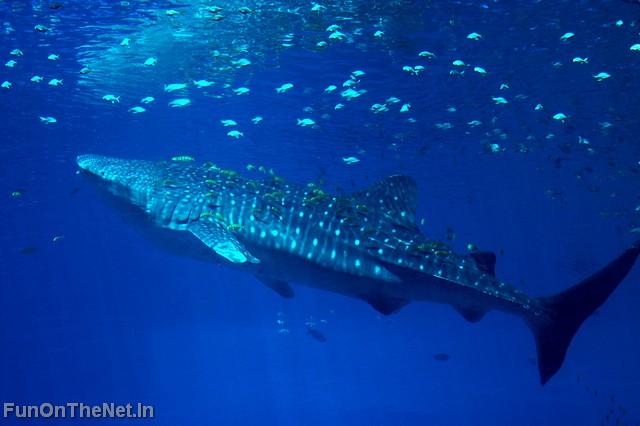
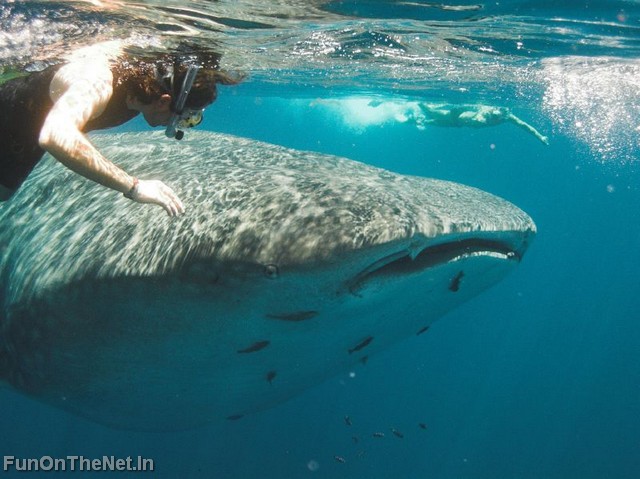
This distinctively-marked shark is the only member of its genusRhincodon and its family, Rhincodontidae (called Rhinodontes before 1984), which is grouped into the subclass Elasmobranchii in the class Chondrichthyes.
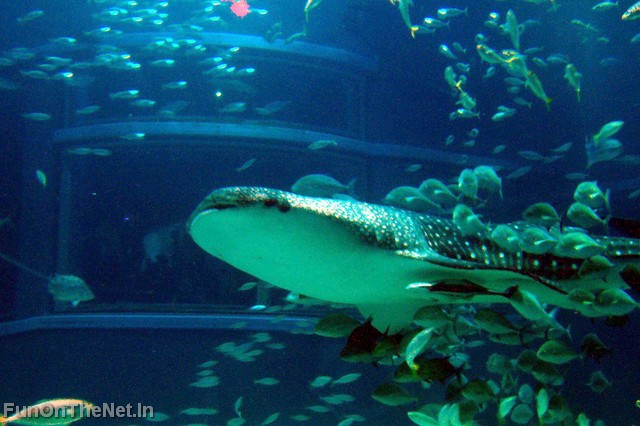

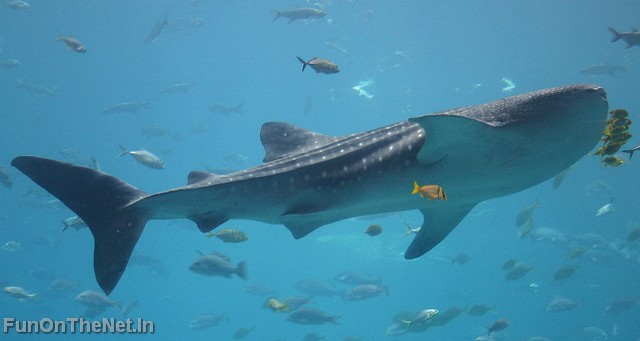
The species was first identified in April 1828 following the harpooning of a 4.6-metre (15.1 ft) specimen in Table Bay, South Africa. It was described the following year by Andrew Smith, a military doctor associated with British troops stationed in Cape Town. He proceeded to publish a more detailed description of the species in 1849. The name “whale shark” comes from the fish’s physiology; that is, a shark as large as a whale that shares a similar filter feeder eating mode. Known as a deity in a Vietnamese religion, the whale shark is called “Ca Ong”, which literally translates as “Sir Fish”.
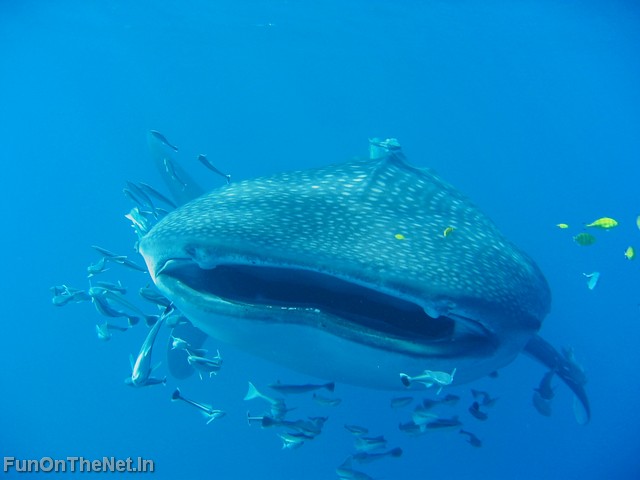
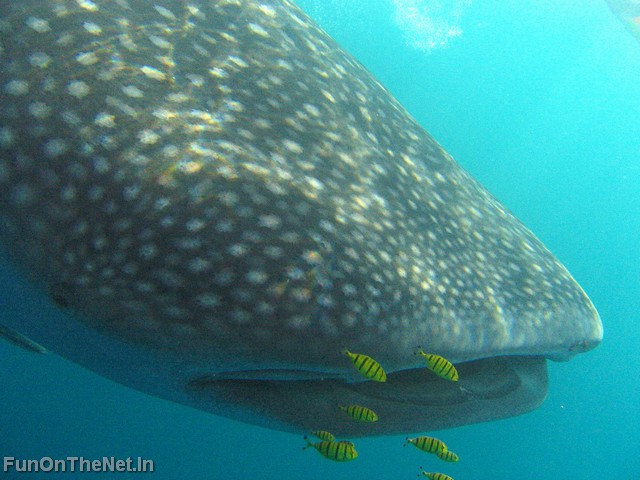

In Mexico, and throughout much of Latin America, the whale shark is known as “pez dama” or “domino” for its patterns of spots. Whales sharks go by the name of “Sapodilla Tom” in Belize due to the regularity of sightings near the Sapodilla Cayes on the Belize Barrier Reef. In Africa, the names for the whale shark are very evocative: “Papa Shillingi” in Kenya came about as it is believed that God threw shillings upon the shark which are now its spots, and in Madagascar whale sharks are known locally as “Marokintana” which means “Many stars”. In Indonesia, Javanese also called this species referring to star as “geger lintang” which has meaning “stars in the back”.
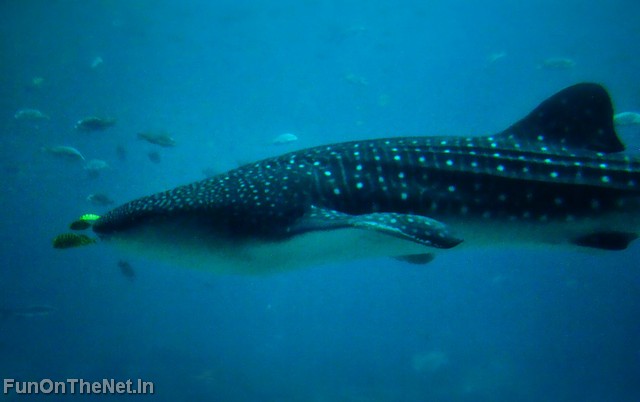
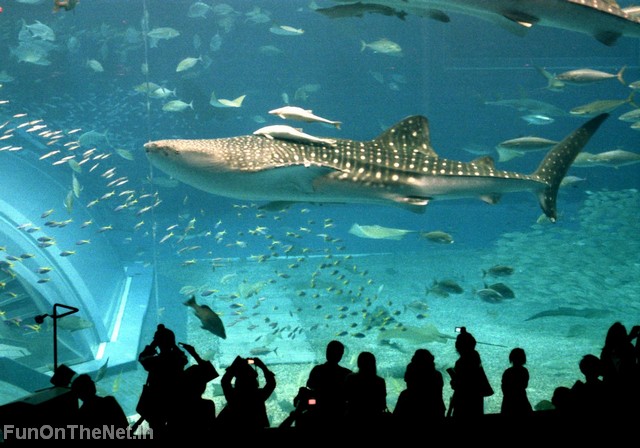
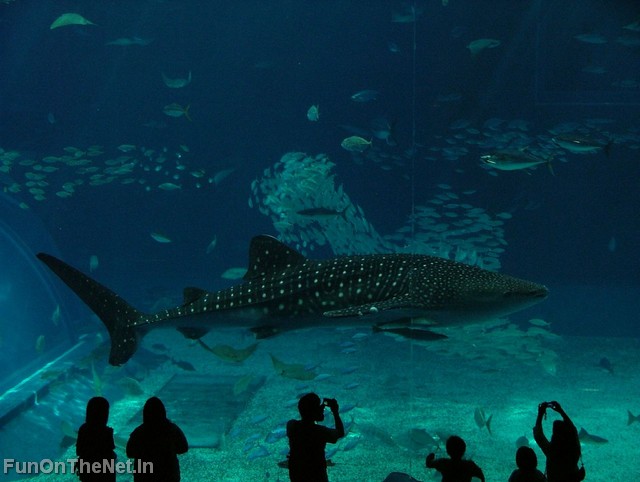
The whale shark is a filter feeder — one of only three known filter feeding shark species (along with the basking shark and the megamouth shark). It feeds on phytoplankton, macro-algae, plankton, krill and small nektonic life, such as small squid or vertebrates. The many rows of teeth play no role in feeding; in fact, they are reduced in size in the whale shark. Instead, the shark sucks in a mouthful of water, closes its mouth and expels the water through its gills.
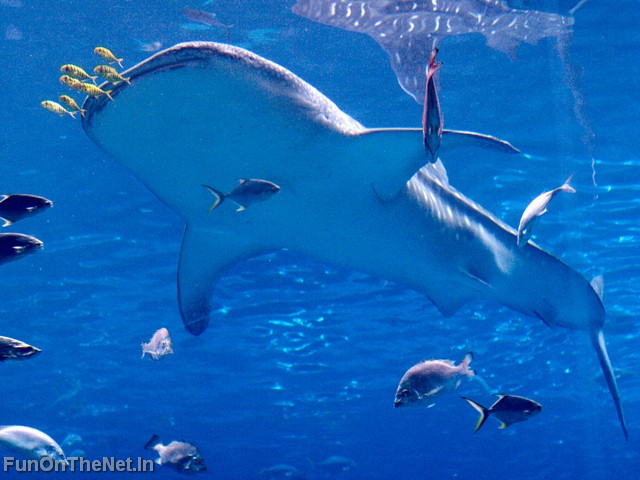
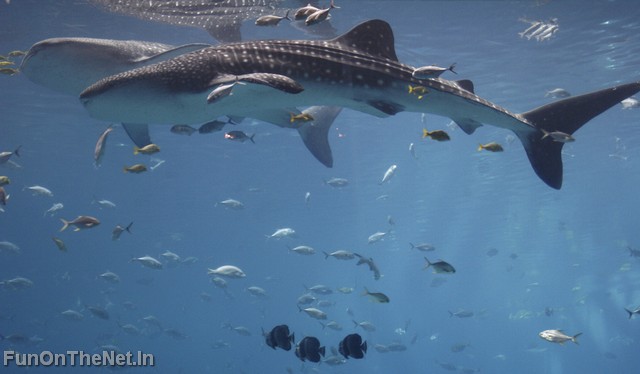

During the slight delay between closing the mouth and opening the gill flaps, plankton is trapped against the dermal denticles which line its gill plates and pharynx. This fine sieve-like apparatus, which is a unique modification of the gill rakers, prevents the passage of anything but fluid out through the gills (anything above 2 to 3 mm in diameter is trapped). Any material caught in the filter between the gill bars is swallowed. Whale sharks have been observed “coughing” and it is presumed that this is a method of clearing a build up of food particles in the gill rakers.
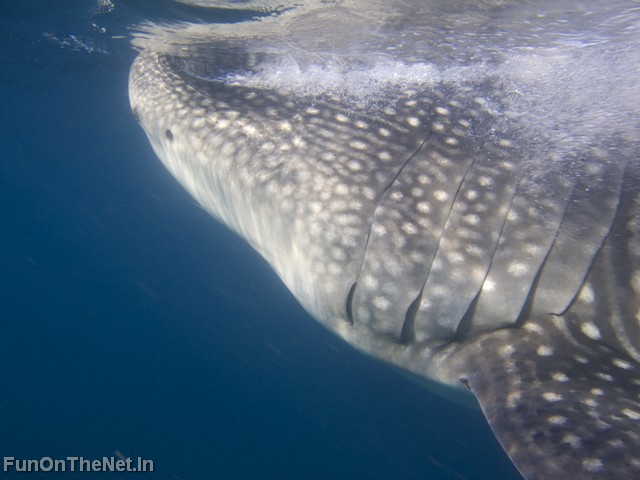
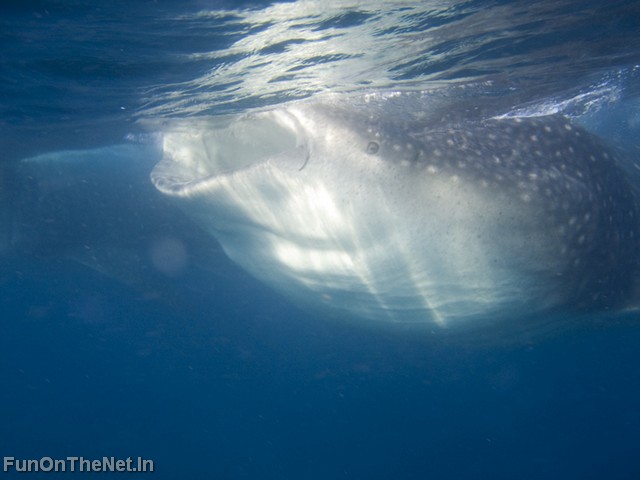
Whale sharks congregate at reefs off the Belizean Caribbean coast, supplementing their ordinary diet by feeding on the spawn of giant cubera snappers, which spawn in these waters between the full and new moons of March through September.

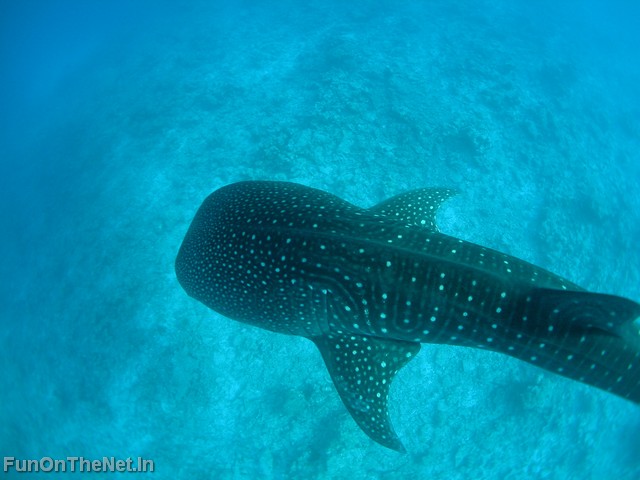
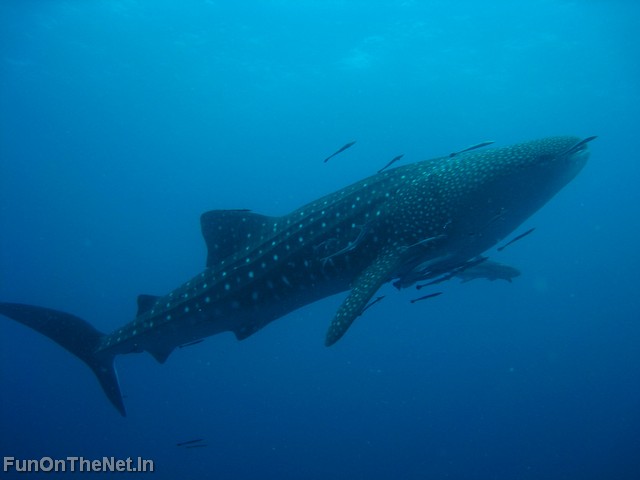
Biggest Dogs, Smallest Dogs!
A collection of the dogs from the biggest to the smallest, from the Chihuahua to the English Mastiff and the Great Dane! Eisenhower said, “What counts is not necessarily the size of the dog in the fight — it’s the size of the fight in the dog.” So very true!
SMALLEST
“Danka”, a long-haired Chihuahua from Revuca, Slovakia, weighed in at just 27 oz (7.4″ long). Danka is very small even for a Chihuahua! “Danka who isn’t that keen on dog food only eats a small amount of dry food crushed up”, Owner Kvetko said.
Smallest – Chihuahua Danka
Smallest – Chihuahua Danka
BIGGEST (LIVING)
“Hercules”, an English Mastiff with a 38″ neck, is the current record holder at 282 lbs. His guardian John Flynn (who ain’t so shabby himself at 270 lbs) says he once saw a bird roosting on Hercules’ head. Hercules just sat there blinking, says Mr. Flynn. “He’s not the smartest dog in the world, that’s for sure.”
Biggest – English Mastiff Hercules
SHORTEST
Brandy”, a Chihuahua from Florida, weighs 2 oz more than Danka but measures only 6″ from the tip of her nose to the end of her tail. Now there’s a dog who has a good reason to be afraid of the vacuum cleaner.
Shortest Chihuahua Brandy
Shortest Chihuahua Brandy
BIGGEST (EVER)
In 1989, an English Mastiff named “Zorba” tipped the scales—or should I say demolished the scales—at a whopping 343 lbs at the age of 8.
In 1989, an English Mastiff named “Zorba” tipped the scales—or should I say demolished the scales—at a whopping 343 lbs at the age of 8.
An English Mastiff
TALLEST
Try telling a 7 ft tall dog not to drool on the dinner table. “Gibson”, a Harlequin Great Dane from Grass Valley, California, is 42.2 inches when standing on all fours, and when he’s on his hind legs he’s positively stratospheric. This dog is so tall he has to bend down to howl at the moon. He’s so tall he doesn’t drink out of the toilet; he drinks from the bidet. He’s so tall he doesn’t understand “heel”. You have to say, “Skull!” He’s so tall… ok I’ll stop now
Try telling a 7 ft tall dog not to drool on the dinner table. “Gibson”, a Harlequin Great Dane from Grass Valley, California, is 42.2 inches when standing on all fours, and when he’s on his hind legs he’s positively stratospheric. This dog is so tall he has to bend down to howl at the moon. He’s so tall he doesn’t drink out of the toilet; he drinks from the bidet. He’s so tall he doesn’t understand “heel”. You have to say, “Skull!” He’s so tall… ok I’ll stop now
Tallest Great Dane – Gibson
Tallest Great Dane – Gibson
LARGEST
“Moose” weighed in at 286 lbs when he was named “largest dog in America” on Live with Regis & Kelly in Nov 2001. Moose’s guardian Donna Vazquez considers that to be a low estimate because his butt wouldn’t fit entirely on the scale.
“Moose” weighed in at 286 lbs when he was named “largest dog in America” on Live with Regis & Kelly in Nov 2001. Moose’s guardian Donna Vazquez considers that to be a low estimate because his butt wouldn’t fit entirely on the scale.
Largest Dog Moose
World’s Biggest Airplanes : Huge Aviation
For a few thousand years the biggest things in the skies were only in our imaginations, flying figments of myth and fable: the Roc from Sinbad’s tales, the Garuda bird from the Mahabharata, the Thunderbird from North America, the Brazilian Blue Crow, and other high-flying nightmares or soaring benevolent gods and spirits.
World’s Biggest Airplanes
Sputtering, Creaking, Terrifying Monsters
The Wright Brothers are often given most of the recognition for the first powered flight but Gustave Whitehead, Alexander Feodorovich Mozhaiski, Clement Ader, and many others should get a share of the fame, too. Whoever is responsible, it wasn’t long before the skies were full of sputtering, creaking, and – for the most part – very unreliable aeronautical devices.
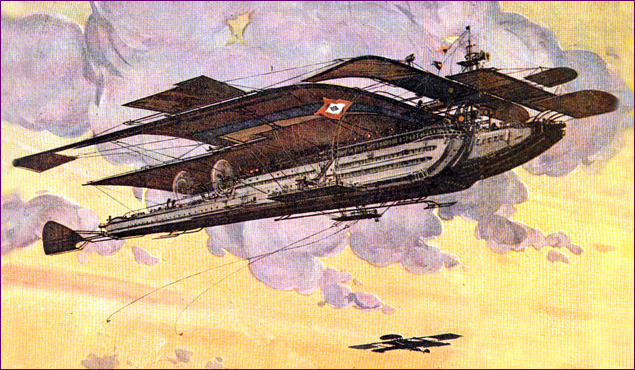
(futuristic art by Harry Grant Dart)
It took the first world war to change aircraft from a killing and maiming hobby for the rich to a killing and maiming war machine. War helped advance the science of flight and necessitated bigger planes.
One monster plane of that time was Igor Sikorsky’s Ilya Murometz, a huge improvement over his legendary Russky Vitaz, the first four engine aircraft. But the Ilya Murometz didn’t begin as a beast of the skies. Originally designed as a luxurious passenger liner featuring electric lighting, heat, a bathroom, and even a glass floor, the bomber must have been amusing as well as terrifying to its wealthy passengers.
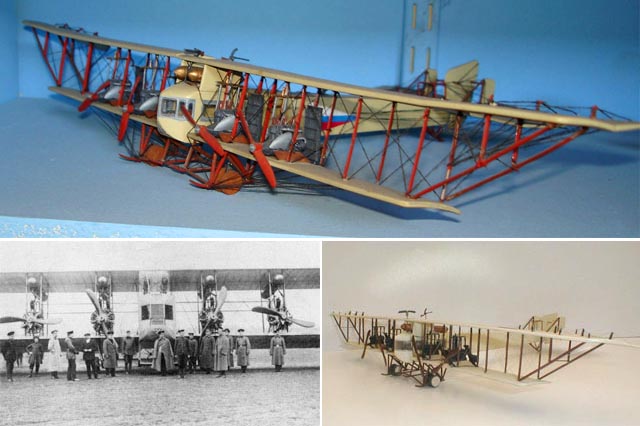
(images credit: histarmar.com.ar)
Another iteration of such approach was Tupolev ANT-20 “Maxim Gorky”:
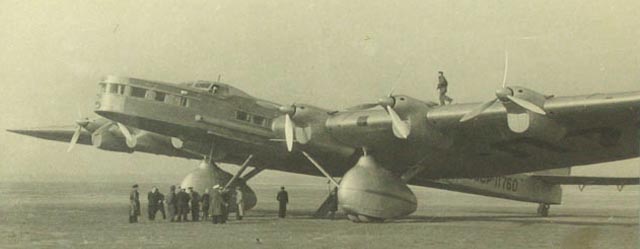
And a really huge Russian monster plane from the early 1930s: Ka-7(more info), named after engineer Kalinin, not the famous political figure.
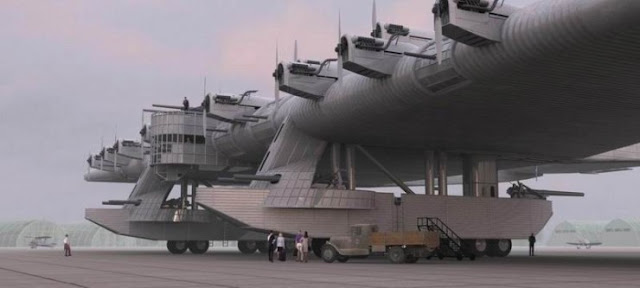
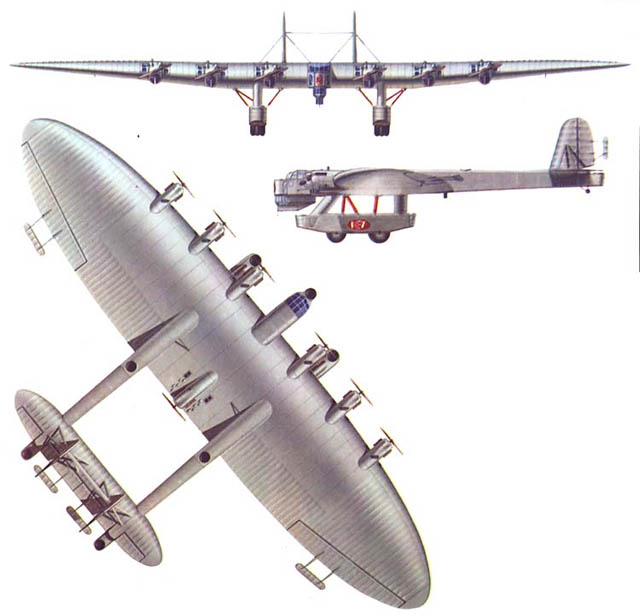
(images via Modelist-Konstruktor, 1989)
Art and Elegance Between Wars
In the years between wars, airplanes kept getting bigger. Outrageous concepts like Norman Bel Geddes Airliner Number 4 appeared, featuring 9 decks of luxury hotel accommodation, bars and engine rooms:
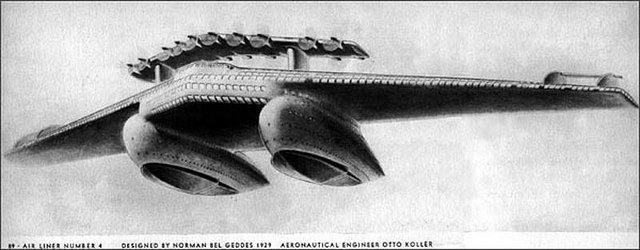

It would sleep 606 passenger in comfort, easily bringing them across Atlantic. More images and info about Bel Geddes fantastic dream planes are here. It seems to be a logical development of 1910s British Airliner of the Future:
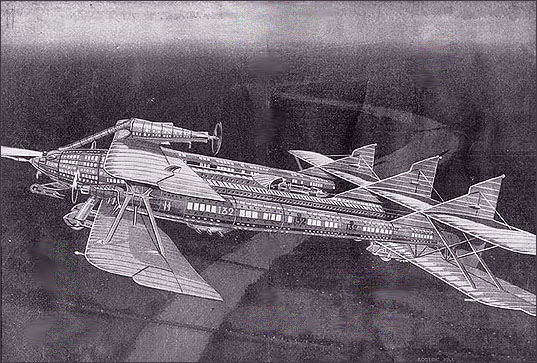
(image via)
Don’t miss also this “Freak of the Month” concept from Modern Mechanics, 1931:
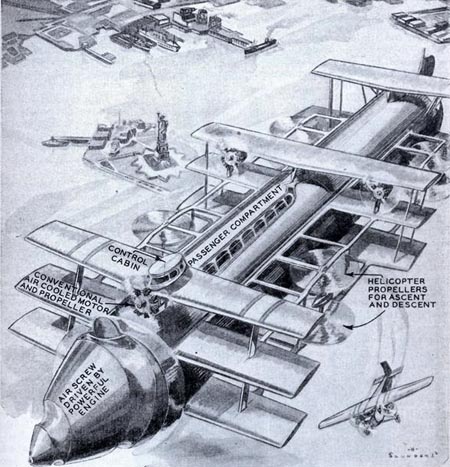
(image credit: modernmechanix)
But let us get back from aviation dreams to reality. Take the elegantHandley Page HP42, for instance: a four-engined beauty with an impressive track record of no crashes while being used as an airliner — which gives you an idea of how safe it was to fly back then.
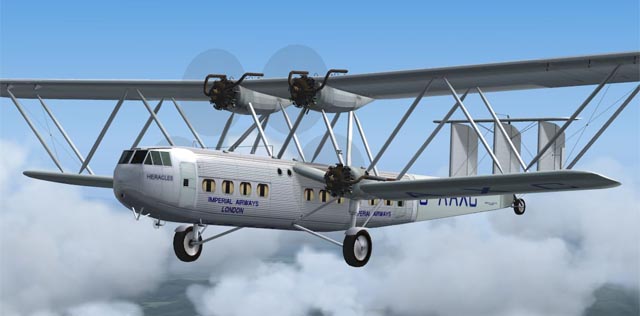
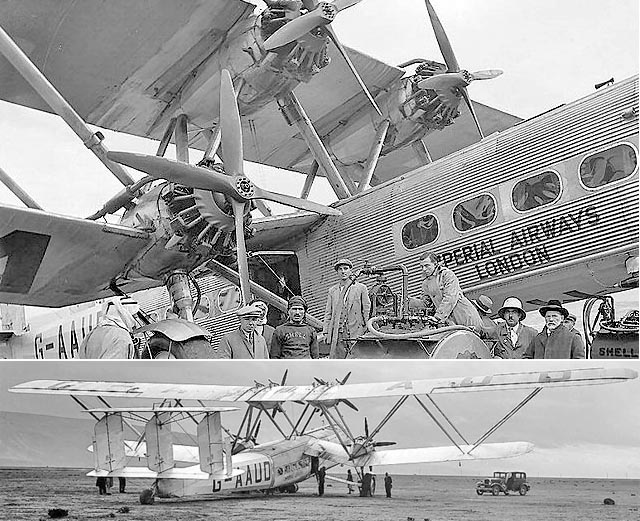
(images via)
One of the larger and more beautiful aircraft in the next few decades was the awesome 1936 Boeing Stratoliner. Unfairly called a ‘whale’ because of its chubbiness, the plane was not only huge but also state of the art; today we enjoy flying in pressurized comfort because of technology premiered in the silver flying fish of the Stratoliner.
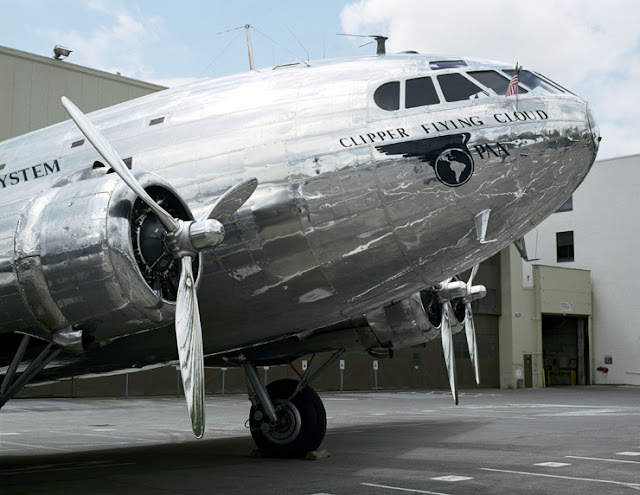
Another aircraft both immense and legendary – The H-4 Hercules. Arguably the standard by which “huge aircraft” are measured –- as well as how “completely screwed up” is defined. Its one and only flight was in 1947, where it flew for around a mile, reaching altitude of 70 feet. Originally planned as the ultimate military transport, it is more commonly known as its hated — at least by its creator Howard Hughes — moniker,the Spruce Goose.

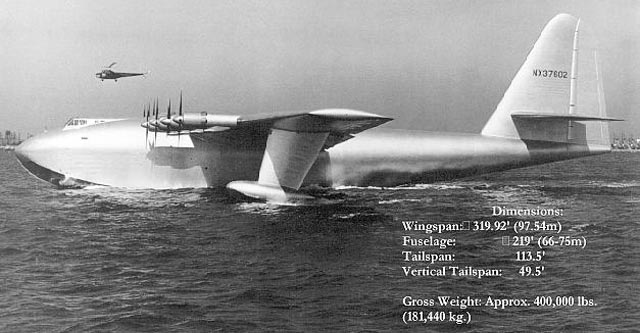
(image credit: Bettman/CORBIS)
The aircraft had originally been ordered by the US government during World War II as a giant cargo plane for the armed troops and tanks. Howard Hughes’s creation was the world’s largest plane at the time and is still the largest flying boat ever built. It also holds records for the largest wingspan at 97.5 meters, tallest airplane at 24.2 meters, and the largest aircraft ever made from wood.
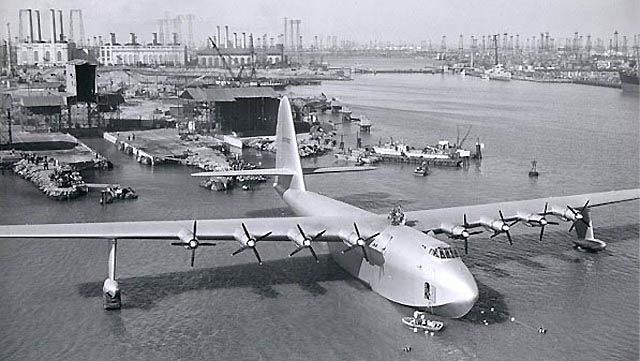
Nazi’s Ugly Brute
Art and elegance may have been one of the early fatalities in the second world war, but striving to have the biggest (anything) certainly wasn’t.
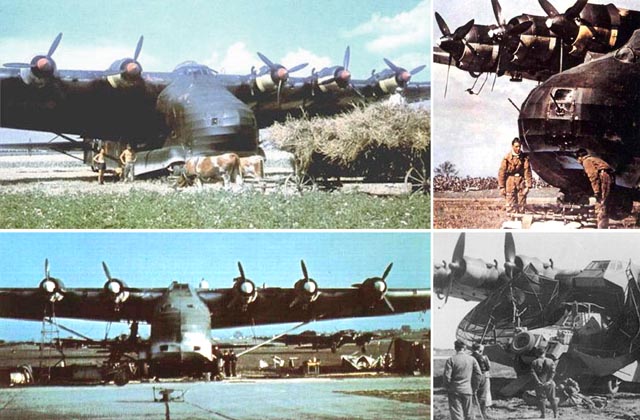
To call the Messerschmitt Me 321 big is like calling 1939 to 1945 unpleasant. Created originally as a glider, the Gigant could haul an insanely large amount of cargo. And an insane bunch of soldiers: 130 plus hardware … 23 tons of hardware.
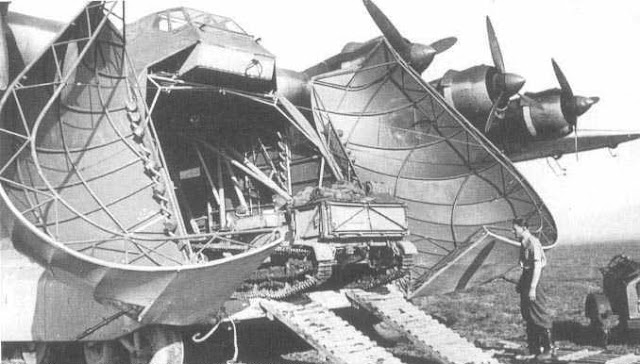
(images via)
Because the Gigant was so huge, getting the damned thing into the air was, at best, problematic. First it was towed up with a pair of Heinkel 111 bombers, which was alternatively unsuccessful or disastrous. Then they tried fusing two 111s together to make a Frankenstein’s monster of a machine –- almost as bestial as the Gigant itself. Finally the Luftwaffe stuck engines on the Me321, which made an ugly brute even uglier but at least it got off the ground.
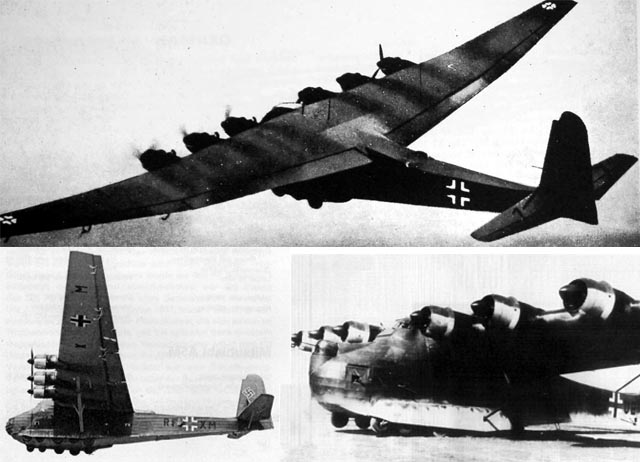
Heavy Bombers of the (Potential) Doomsday
On the other side of the war was an eagle, a silvery steel bird of prey: the huge and beautiful B-29 Superfortress. Although getting the immense B-29 up to its ceiling of 40,000 feet was a struggle, once it got up there nothing could reach it or, at 350 mph, catch it. Even if something managed to come close to it, its formidable defenses could cut any threat to shreds. Featuring many impressive advancements, and some frustrating problems, the plane was kept on active duty long into the Korean war.
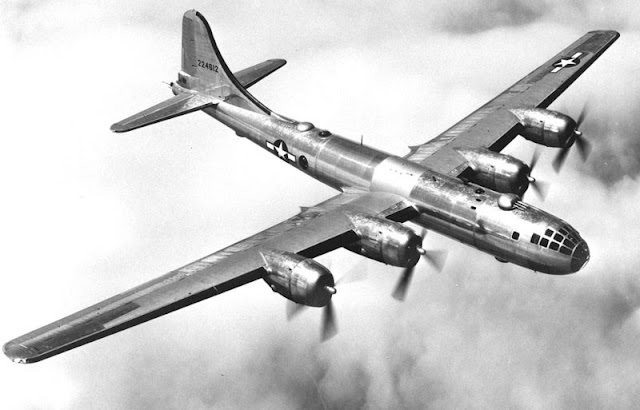
(image via)
With the advent of jet power, aircraft designers began to think really big. Think of your average doomsday film and you immediately picture the roaring ascent of smoke-blasting, eight-engined, B-52 bombers. But before B-52 there was another huge American bomber: Convair B-36“Peacemaker”:
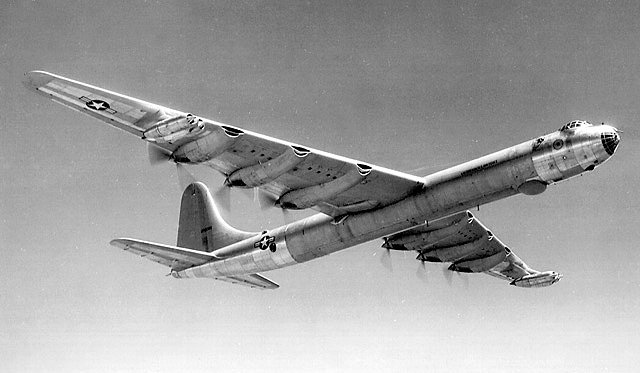
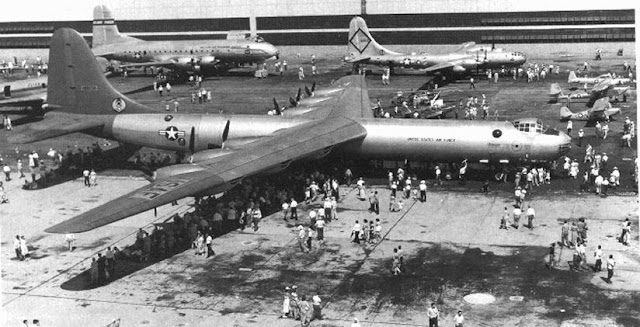
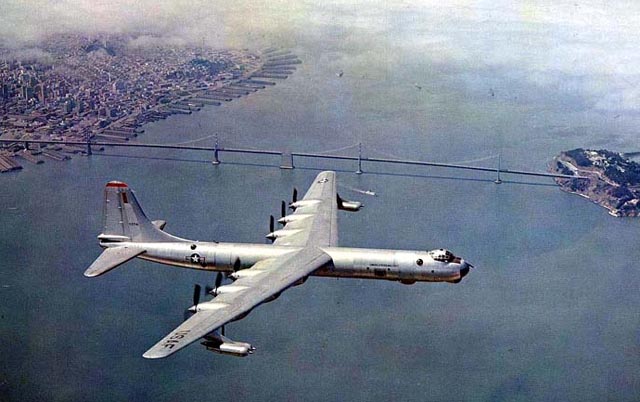
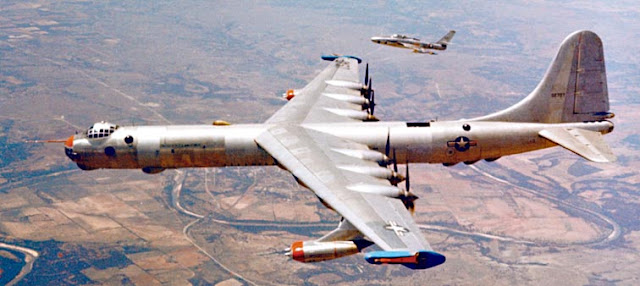
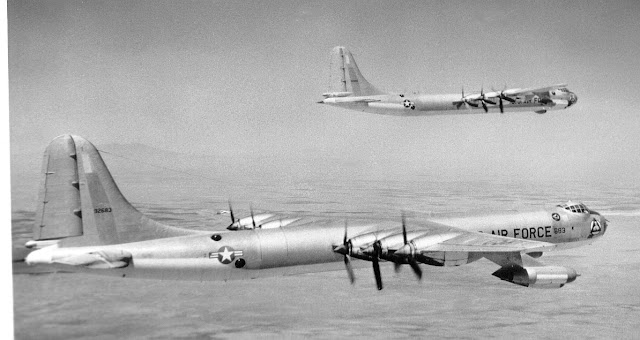
(images via)
Like the B-29, the B-52 “Stratofortress” was an aeronautical powerhouse, a heavy-lifting behemoth. And like the B-52, it was kept in service until … well, they are still being used today.

(image source: US Air Force)
Heavy bombers transforming into LEGO pieces in the minds of dazed Cold War engineers:
Arthur Kimes writes to us: “Soviets also proposed to stick together a bunch of big airplanes to make a REALLY huge one. Kind of like a Lego dream come true: In the early-mid 1950s the USAF had a plan to link 3 B-36s (wingtip to wingtip) to have a extended range delivery system. When this behemoth got close enough to the Soviet Union each would drop off a parasite fighter-bomber (probably the F-92 – which also was never built) and the released FBs would make a high-speed dash and drop a bomb on their targets. The B-36s would split up and return, the F-92s would have to try and find a friendly airfield in Turkey or something like that.”
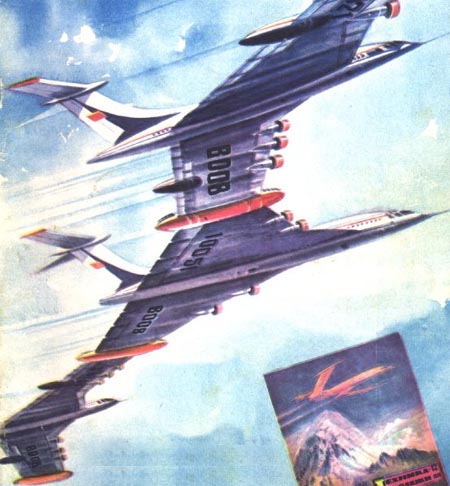
(image source: TM, 1975)
“When you consider the B-36 is still the largest bomber ever built, the idea of 3 of them flying joined at the wingtips is astounding.”
The Ugliest Airplane Ever Built?
The Aero Spacelines Super Guppy looks more like a prop from a Japanese monster movie than a real airplane. The Guppy is also high on the irony meter as it was mostly used to haul nearly-completed components — of other airplanes.

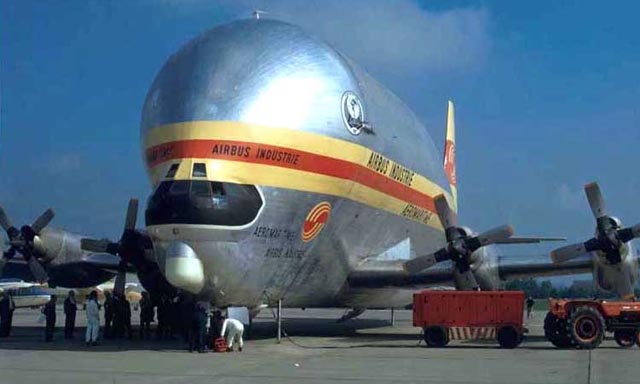
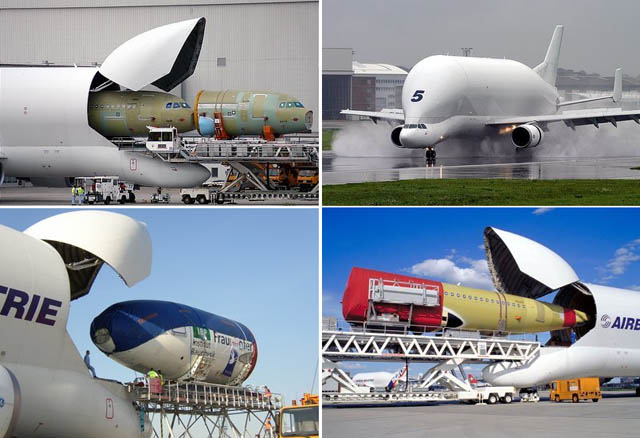
(images credit: Mischa Oordjik, Alastair T. Garoiner)
The Airbus A300-600ST (Super Transporter) or Beluga:
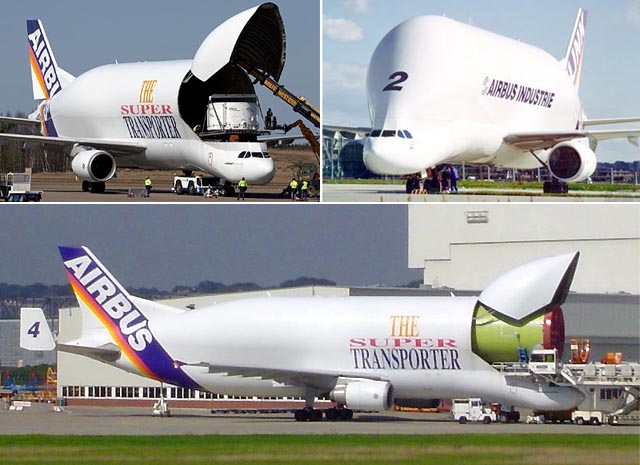
(images via)
Here is a Russian carrier VM-T “Atlant” used in a Buran and Energia space programs, which is perhaps the only airplane capable of carrying on its “shoulders” a load larger and heavier than itself:
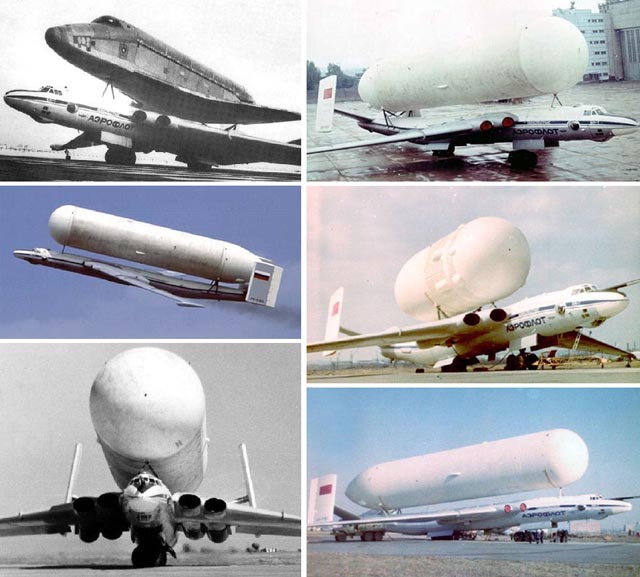
(images via)
Transporting a fuel tank for the second stage of Energia rocket:
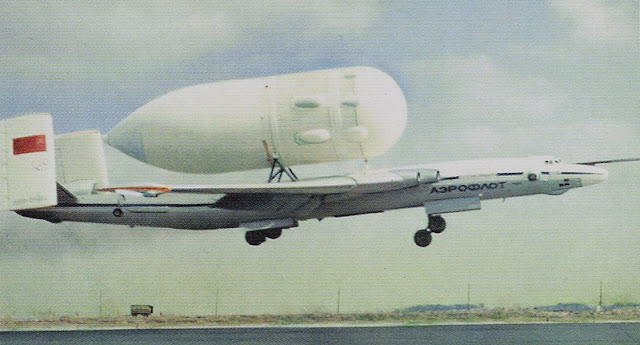
(image source: “Cosmonautics – A Colorful History” ed. by Dr. Wayne R. Matson)
Nuclear-Powered Lockheed Mothership
Nothing comes close in size to this unbelievable concept developed by Lockheed in the 1970s:
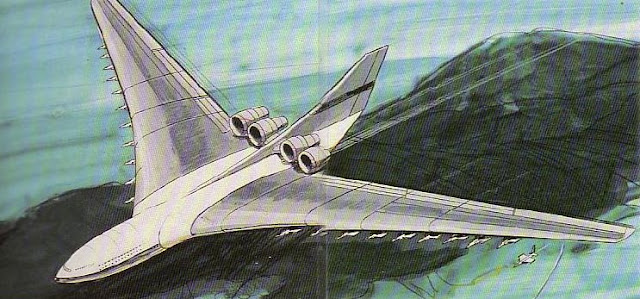
Note small “children” airplanes, attached to its wings… Its hard to imagine anything bigger flying in the skies, still retaining the shape of a common airliner. An aircraft of this size would have to land on water as a titanic “flying boat”.
The Biggest Planes Flying Today
Unlike the B-29 and the B-52, which don’t show their size easily, the C-5 Galaxy would look insanely monstrous even on a postage stamp. To give you an idea of the Galaxy’s size, its wingspan is not just longer than the Wright Brothers’ first flight but the beast can also haul 180,000 pounds (which is about 90 tons). The C-5 was the world’s largest plane when it was introduced in the late 1960s.

(image credit: Pervez Iqbal)
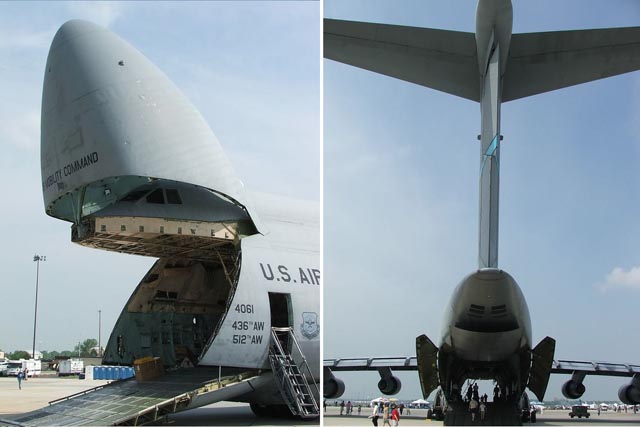
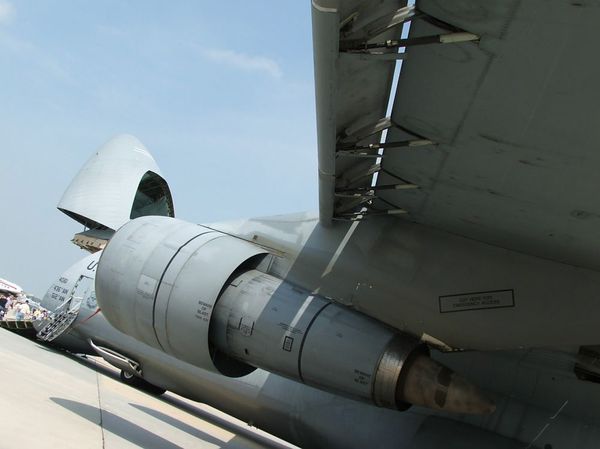
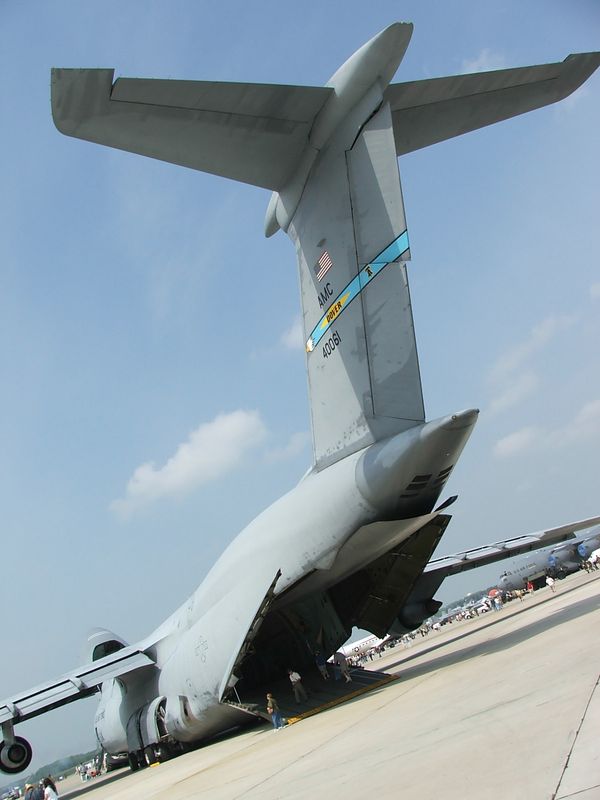
Arguably the biggest plane flying today, or ever, is Antonov An-225, a 6-engine beast that’s not only longer than the first flight in history but could probably carry one, two, or three whole aircraft museums. Numbers don’t mean much but here is an impressive one: the 225 can carry 550,000 pounds, which is 275 tons. Yes, you can say WOW.
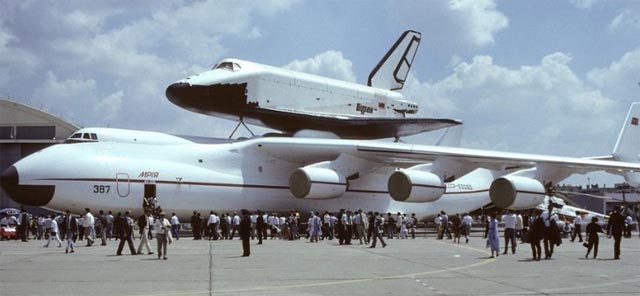
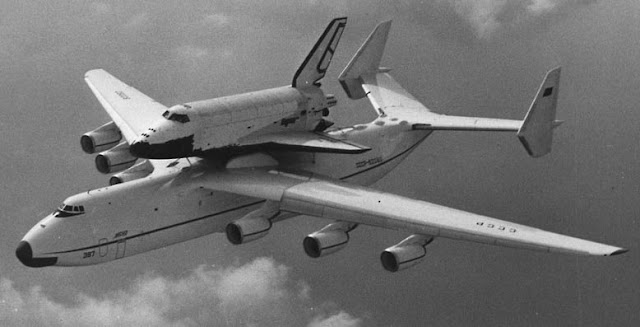
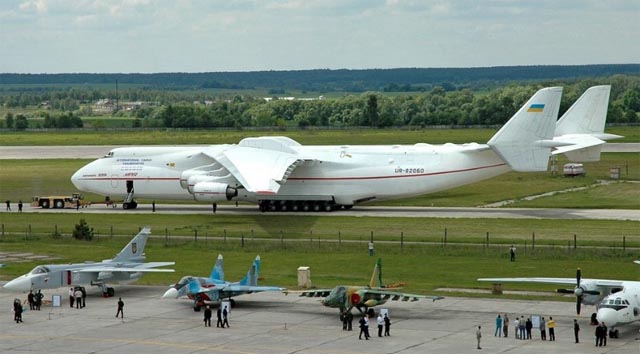
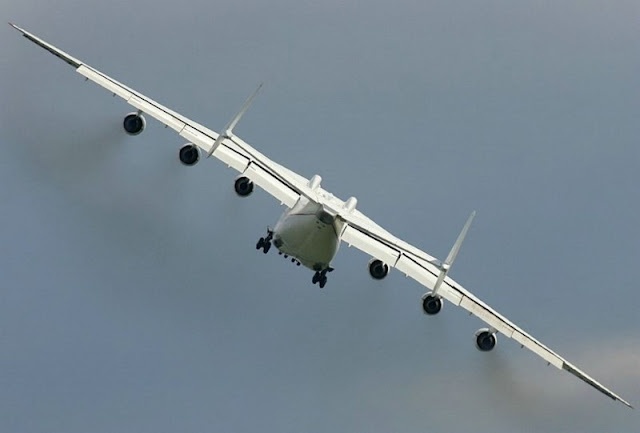
(image credit: Dmitry Pichugin)
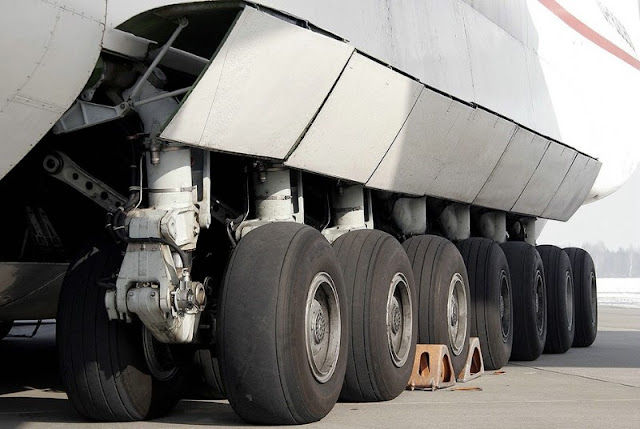
(image credit: Radek Oneksiak)
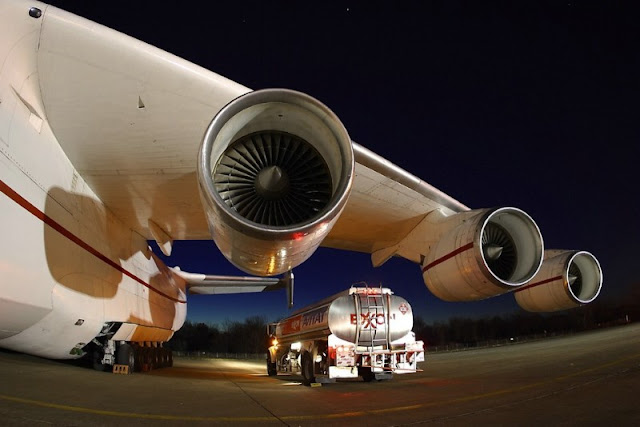
(image credit: airliners.net)

(images via)
This is a good dimension-comparison chart:
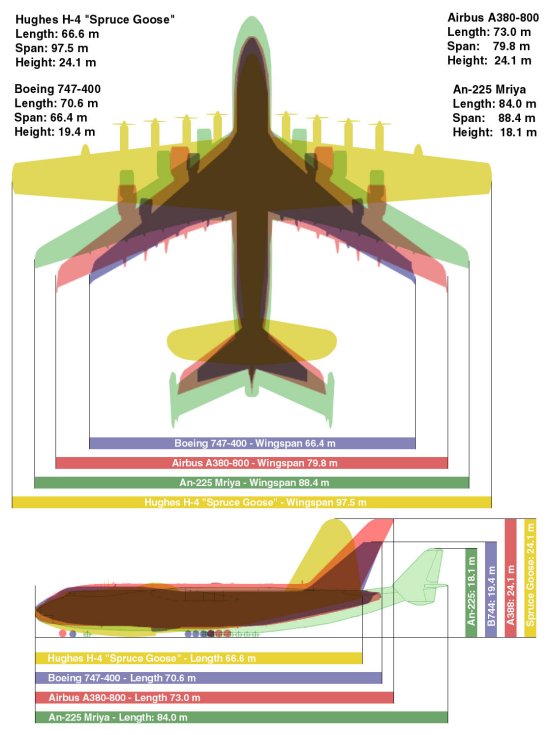
(image via)
When it comes to passenger aviation, Airbus A-380 is the current leader in size: this image shows its comparative size among other planes in the airport -
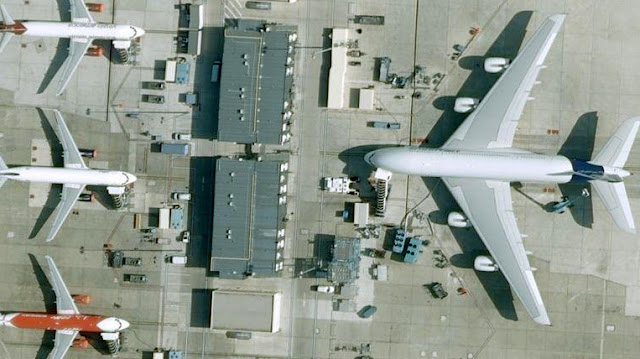
We used to have the Roc, the Garuda bird, the Thunderbird, Blue Crow, and other soaring myths. Now we have machines; airplanes so big they’re even greater than those ancient, and magnificent, dreams. Of course, there is another advantage to premium size – you can always claim your piece of the sky, and outright own the airstrip:
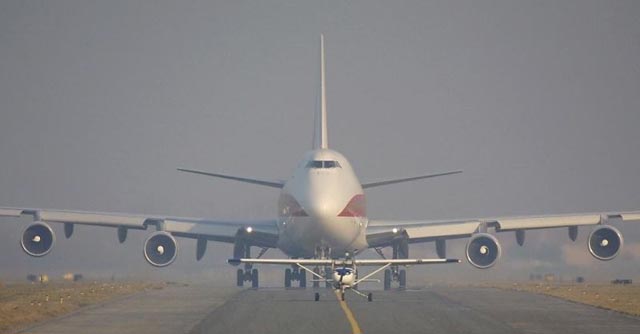
(image credit: Sven De Bevere)
The Wright Brothers are often given most of the recognition for the first powered flight but Gustave Whitehead, Alexander Feodorovich Mozhaiski, Clement Ader, and many others should get a share of the fame, too. Whoever is responsible, it wasn’t long before the skies were full of sputtering, creaking, and – for the most part – very unreliable aeronautical devices.

(futuristic art by Harry Grant Dart)
It took the first world war to change aircraft from a killing and maiming hobby for the rich to a killing and maiming war machine. War helped advance the science of flight and necessitated bigger planes.
One monster plane of that time was Igor Sikorsky’s Ilya Murometz, a huge improvement over his legendary Russky Vitaz, the first four engine aircraft. But the Ilya Murometz didn’t begin as a beast of the skies. Originally designed as a luxurious passenger liner featuring electric lighting, heat, a bathroom, and even a glass floor, the bomber must have been amusing as well as terrifying to its wealthy passengers.

(images credit: histarmar.com.ar)
Another iteration of such approach was Tupolev ANT-20 “Maxim Gorky”:

And a really huge Russian monster plane from the early 1930s: Ka-7(more info), named after engineer Kalinin, not the famous political figure.


(images via Modelist-Konstruktor, 1989)
Art and Elegance Between Wars
In the years between wars, airplanes kept getting bigger. Outrageous concepts like Norman Bel Geddes Airliner Number 4 appeared, featuring 9 decks of luxury hotel accommodation, bars and engine rooms:


It would sleep 606 passenger in comfort, easily bringing them across Atlantic. More images and info about Bel Geddes fantastic dream planes are here. It seems to be a logical development of 1910s British Airliner of the Future:
(image via)
Don’t miss also this “Freak of the Month” concept from Modern Mechanics, 1931:

(image credit: modernmechanix)
But let us get back from aviation dreams to reality. Take the elegantHandley Page HP42, for instance: a four-engined beauty with an impressive track record of no crashes while being used as an airliner — which gives you an idea of how safe it was to fly back then.


(images via)
One of the larger and more beautiful aircraft in the next few decades was the awesome 1936 Boeing Stratoliner. Unfairly called a ‘whale’ because of its chubbiness, the plane was not only huge but also state of the art; today we enjoy flying in pressurized comfort because of technology premiered in the silver flying fish of the Stratoliner.

Another aircraft both immense and legendary – The H-4 Hercules. Arguably the standard by which “huge aircraft” are measured –- as well as how “completely screwed up” is defined. Its one and only flight was in 1947, where it flew for around a mile, reaching altitude of 70 feet. Originally planned as the ultimate military transport, it is more commonly known as its hated — at least by its creator Howard Hughes — moniker,the Spruce Goose.


(image credit: Bettman/CORBIS)
The aircraft had originally been ordered by the US government during World War II as a giant cargo plane for the armed troops and tanks. Howard Hughes’s creation was the world’s largest plane at the time and is still the largest flying boat ever built. It also holds records for the largest wingspan at 97.5 meters, tallest airplane at 24.2 meters, and the largest aircraft ever made from wood.

Nazi’s Ugly Brute
Art and elegance may have been one of the early fatalities in the second world war, but striving to have the biggest (anything) certainly wasn’t.

To call the Messerschmitt Me 321 big is like calling 1939 to 1945 unpleasant. Created originally as a glider, the Gigant could haul an insanely large amount of cargo. And an insane bunch of soldiers: 130 plus hardware … 23 tons of hardware.

(images via)
Because the Gigant was so huge, getting the damned thing into the air was, at best, problematic. First it was towed up with a pair of Heinkel 111 bombers, which was alternatively unsuccessful or disastrous. Then they tried fusing two 111s together to make a Frankenstein’s monster of a machine –- almost as bestial as the Gigant itself. Finally the Luftwaffe stuck engines on the Me321, which made an ugly brute even uglier but at least it got off the ground.

Heavy Bombers of the (Potential) Doomsday
On the other side of the war was an eagle, a silvery steel bird of prey: the huge and beautiful B-29 Superfortress. Although getting the immense B-29 up to its ceiling of 40,000 feet was a struggle, once it got up there nothing could reach it or, at 350 mph, catch it. Even if something managed to come close to it, its formidable defenses could cut any threat to shreds. Featuring many impressive advancements, and some frustrating problems, the plane was kept on active duty long into the Korean war.

(image via)
With the advent of jet power, aircraft designers began to think really big. Think of your average doomsday film and you immediately picture the roaring ascent of smoke-blasting, eight-engined, B-52 bombers. But before B-52 there was another huge American bomber: Convair B-36“Peacemaker”:





(images via)
Like the B-29, the B-52 “Stratofortress” was an aeronautical powerhouse, a heavy-lifting behemoth. And like the B-52, it was kept in service until … well, they are still being used today.

(image source: US Air Force)
Heavy bombers transforming into LEGO pieces in the minds of dazed Cold War engineers:
Arthur Kimes writes to us: “Soviets also proposed to stick together a bunch of big airplanes to make a REALLY huge one. Kind of like a Lego dream come true: In the early-mid 1950s the USAF had a plan to link 3 B-36s (wingtip to wingtip) to have a extended range delivery system. When this behemoth got close enough to the Soviet Union each would drop off a parasite fighter-bomber (probably the F-92 – which also was never built) and the released FBs would make a high-speed dash and drop a bomb on their targets. The B-36s would split up and return, the F-92s would have to try and find a friendly airfield in Turkey or something like that.”

(image source: TM, 1975)
“When you consider the B-36 is still the largest bomber ever built, the idea of 3 of them flying joined at the wingtips is astounding.”
The Ugliest Airplane Ever Built?
The Aero Spacelines Super Guppy looks more like a prop from a Japanese monster movie than a real airplane. The Guppy is also high on the irony meter as it was mostly used to haul nearly-completed components — of other airplanes.



(images credit: Mischa Oordjik, Alastair T. Garoiner)
The Airbus A300-600ST (Super Transporter) or Beluga:

(images via)
Here is a Russian carrier VM-T “Atlant” used in a Buran and Energia space programs, which is perhaps the only airplane capable of carrying on its “shoulders” a load larger and heavier than itself:

(images via)
Transporting a fuel tank for the second stage of Energia rocket:

(image source: “Cosmonautics – A Colorful History” ed. by Dr. Wayne R. Matson)
Nuclear-Powered Lockheed Mothership
Nothing comes close in size to this unbelievable concept developed by Lockheed in the 1970s:

Note small “children” airplanes, attached to its wings… Its hard to imagine anything bigger flying in the skies, still retaining the shape of a common airliner. An aircraft of this size would have to land on water as a titanic “flying boat”.
The Biggest Planes Flying Today
Unlike the B-29 and the B-52, which don’t show their size easily, the C-5 Galaxy would look insanely monstrous even on a postage stamp. To give you an idea of the Galaxy’s size, its wingspan is not just longer than the Wright Brothers’ first flight but the beast can also haul 180,000 pounds (which is about 90 tons). The C-5 was the world’s largest plane when it was introduced in the late 1960s.

(image credit: Pervez Iqbal)



Arguably the biggest plane flying today, or ever, is Antonov An-225, a 6-engine beast that’s not only longer than the first flight in history but could probably carry one, two, or three whole aircraft museums. Numbers don’t mean much but here is an impressive one: the 225 can carry 550,000 pounds, which is 275 tons. Yes, you can say WOW.




(image credit: Dmitry Pichugin)

(image credit: Radek Oneksiak)

(image credit: airliners.net)

(images via)
This is a good dimension-comparison chart:

(image via)
When it comes to passenger aviation, Airbus A-380 is the current leader in size: this image shows its comparative size among other planes in the airport -

We used to have the Roc, the Garuda bird, the Thunderbird, Blue Crow, and other soaring myths. Now we have machines; airplanes so big they’re even greater than those ancient, and magnificent, dreams. Of course, there is another advantage to premium size – you can always claim your piece of the sky, and outright own the airstrip:

(image credit: Sven De Bevere)
أتمنى منك عزيزي القارئ ان استفدت من الموضوع ان تقوم بنشره مع ذكر المصدر http://mik111.wordpress.com








 0 التعليقات
0 التعليقات